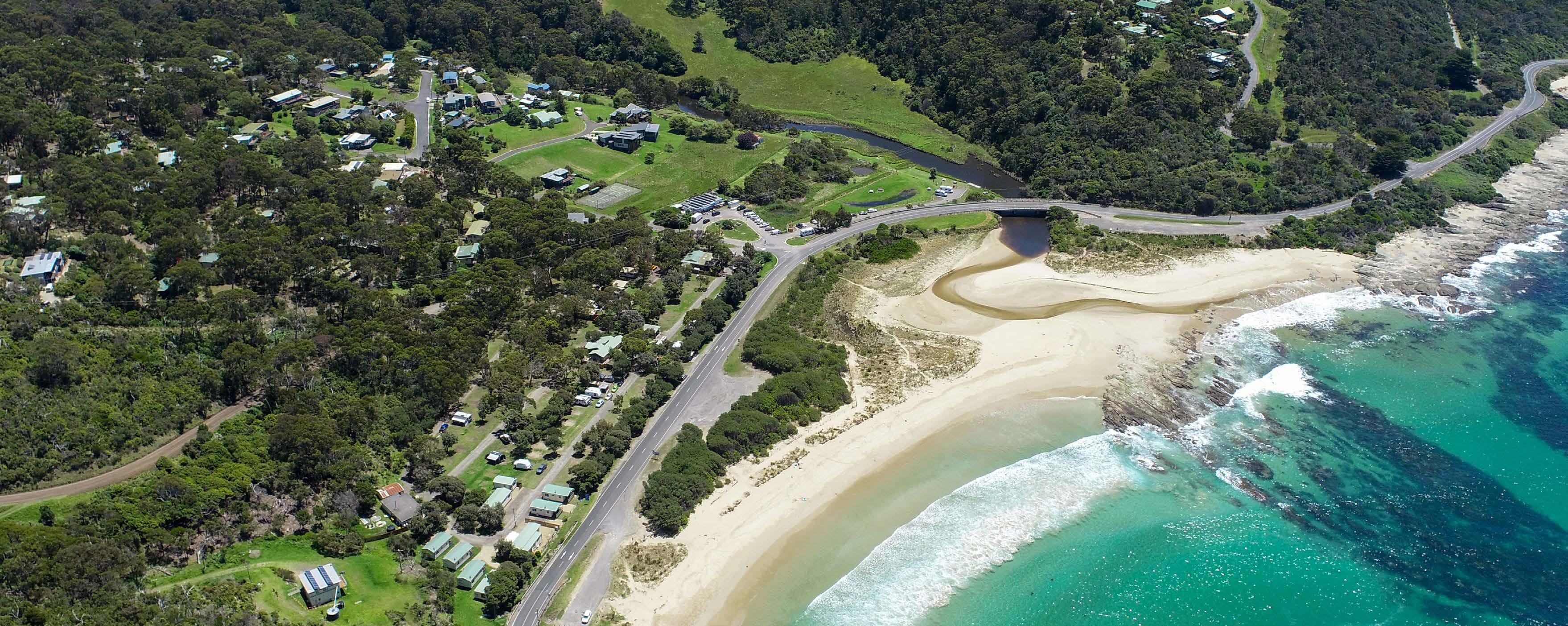KENNETT RIVER PRECINCT PLAN
VISION, GUIDING AND DESIGN PRINCIPLES
OUR VISION
The vision serves as a guiding compass for developing and implementing the Precinct Plan, providing a clear sense of purpose and direction by articulating its aspirations and goals. It has been shaped through careful consideration of community and Community Reference Group feedback, the Opportunities and Constraints Report, background technical documents, and alignment with the protection principles of the Great Ocean Road and Environs Protection Act 2020.
When shared and understood, the vision fosters alignment and commitment, promoting collaboration and communication throughout the planning and implementation process. The guiding and design principles will serve as benchmarks to assess and review the success of the Precinct Plan.
The vision for the Kennett River Precinct is to create a vibrant, accessible, and sustainable coastal community that enhances the natural beauty of the area while providing safe and enjoyable spaces for residents and visitors. By integrating considered design, ecological sensitivity, and community input, the precinct plan aims to improve connectivity, safety, and amenities, fostering a harmonious balance between development and nature.
Social Consideration and Engagement
Respect local character and sense of place
Harmonise with local climate and natural processes
General and Economic Benefit Environmental Advocacy
Aboriginal Inclusion
VISION
Sustainability
Enhance native vegetation and ecology
Improve public access and connectivity
Increase function and adaptability
Retain and enrich views
GUIDING PRINCIPLES
The following principles for the Kennett River Precinct Plan are based on the ‘Great Ocean Road and Environs Protection Act 2020’, Part 3 –Great Ocean Road coast and parks protection principles.
Social Consideration and Engagement
• Community engagement plays an essential role in the development of the Precinct Plan, and an effective role in the ongoing protection, improvement and promotion of the Great Ocean Road coast and parks.
• Balance needs of multiple user groups including local residents, caravan park visitors, day visitors, trail hikers and future users for generations to come.
• The development and implementation of the Precinct Plan should protect and improve community access, including pedestrian access, use and enjoyment and allow for public land uses which align with the site’s carrying capacity.
• Increase amenity, safety and access for alternative transport modes and all-abilities access.
Environmental Advocacy
• Natural, cultural and ecological values should be protected, and cumulative impacts on the environment should be considered in decision-making.
• Decision makers should consider evidence about climate change risks to avoid, so far as possible, serious or irreversible damage resulting from climate change.
• If there are threats of serious or irreversible damage to the environment, a lack of full scientific certainty should not be used as a reason for postponing measures to prevent or minimise those threats.
• There should be a net gain for the environment arising out of any individual change in land use.
GUIDING PRINCIPLES
Aboriginal Inclusion
• Aboriginal cultural values, practices, heritage and knowledge should be acknowledged, respected, protected and promoted.
• The intrinsic connection of the Traditional Owners to Country should be acknowledged through partnership and involvement in policy development, planning, and decision-making for public land management.
• Traditional Owners should be involved in the integration of their ecological knowledge and land management practices into the management of the Great Ocean Road coast and parks.
General and Economic Benefit
• The amenity and visitor experience of Kennett River, including its natural features, character and appearance, should be protected and enhanced for the benefit of the whole community.
• A holistic approach to the management of the Great Ocean Road coast and parks should be adopted with integrated planning, aligned decision-making and coordinated implementation of planning across all responsible entities.
• Protecting the environment and attracting sustainable investment should be a responsibility shared by all levels of government, industry, business and communities.
• Each generation should ensure that the environmental, social, cultural and economic benefits that have been acquired are maintained or enhanced for the benefit of future generations.
DESIGN PRINCIPLES
Design principles refer to guidelines and conceptual frameworks that help shape the development of the Precinct Plan area. Here are the key Design Principles of the Kennett River Precinct Plan that have been developed through consideration of the site’s opportunities, constraints, community feedback and the ‘Siting and Design Guidelines for Structures on the Victorian Coast’:
Respect local character and sense of place
Prioritising local access and public safety: The Precinct Plan does not allow for large tour coaches to enter or stop within the precinct.
Engagement and Inclusion: Engage with the local community to incorporate their feedback, where appropriate, and ensure the design meets needs, and fosters a sense of identity, ownership and pride.
Materials and finishes: Use materials and design elements that reflect the local context and character.
Cultural Heritage: Respect and incorporate elements of the local cultural heritage into the design, reflecting the area’s history and identity.
Harmonise with local climate and natural processes
Built Form: Design to be resilient to local environmental conditions, such as bushfires, floods, and coastal erosion. Incorporate climate-responsive design, such as bush fire rated material selection, natural ventilation, and rainwater harvesting, etc.
Plant selection: Use indigenous and native drought-tolerant plant species in landscaping. Inclusion of Eastern Maar Aboriginal Corporation in the selection of landscaping of the site.
DESIGN PRINCIPLES
Sustainability
Built Form: Implement sustainable building practices, such as using renewable energy sources, recycling materials, and reducing waste.
Waste and Water Management: Implement effective wastewater and stormwater treatment systems to protect local waterways and wetlands and promote water reuse opportunities.
Landscaping and Re-Vegetation: Support initiatives that protect and restore natural habitats and ecosystems.
Enhance native vegetation and ecology
Improve public access and connectivity
Plant selection: Use indigenous and native plant species in landscaping to support local biodiversity.
Conservation: Protect existing vegetation and natural habitats from development impacts.
Grassroots Initiatives: Enhance native vegetation and biodiversity through grassroots landscaping and revegetation efforts, promoting the health of local ecosystems through local stewardship. Improve access to public amenities block.
Traffic Calming: Implement traffic calming measures, such as raised pedestrian crossings and slower speeds, to enhance pedestrian safety.
Effective Traffic Management: Ensure clear and effective traffic management through strategic line marking, parking durations and signage.
Well-Defined Parking: Design vehicle parking areas that are well-defined and safely integrated with pedestrian pathways.
Universal Design: Provide accessible pathways and facilities for people with disabilities.
Clear Signage and Wayfinding: Provide clear educational, interpretive and wayfinding signage to enhance navigation and safety, making it easier for visitors to explore the area.
DESIGN PRINCIPLES
Increase function and adaptability
Futureproofing: Design functional spaces that can adapt to changing needs, ensuring long-term functionality. Incorporate future-proofing strategies to extend the lifespan of developments.
Flexibility: Use modular and flexible design elements that can be easily adapted or reconfigured, for example use of logs and boulders for seating.
Retain and enrich views
Retain views: Avoid obstructing important sightlines and vistas. Conduct visual impact assessments to understand the effects of developments on key views. Ensure the location of the toilet block does not impact the character of Kennett River.
Enrich Views: Design buildings and landscapes to frame and enhance significant views. Ensure the toilet block building is immersed into the landscape.
Aesthetics and Visual Harmony: Create visually pleasing built form outcomes that complement the natural surroundings and scenic values of the Great Ocean Road.
Cohesive Design Elements: Use a cohesive palette of materials and design elements to ensure a unified aesthetic throughout Kennett River and the Great Ocean Road.






